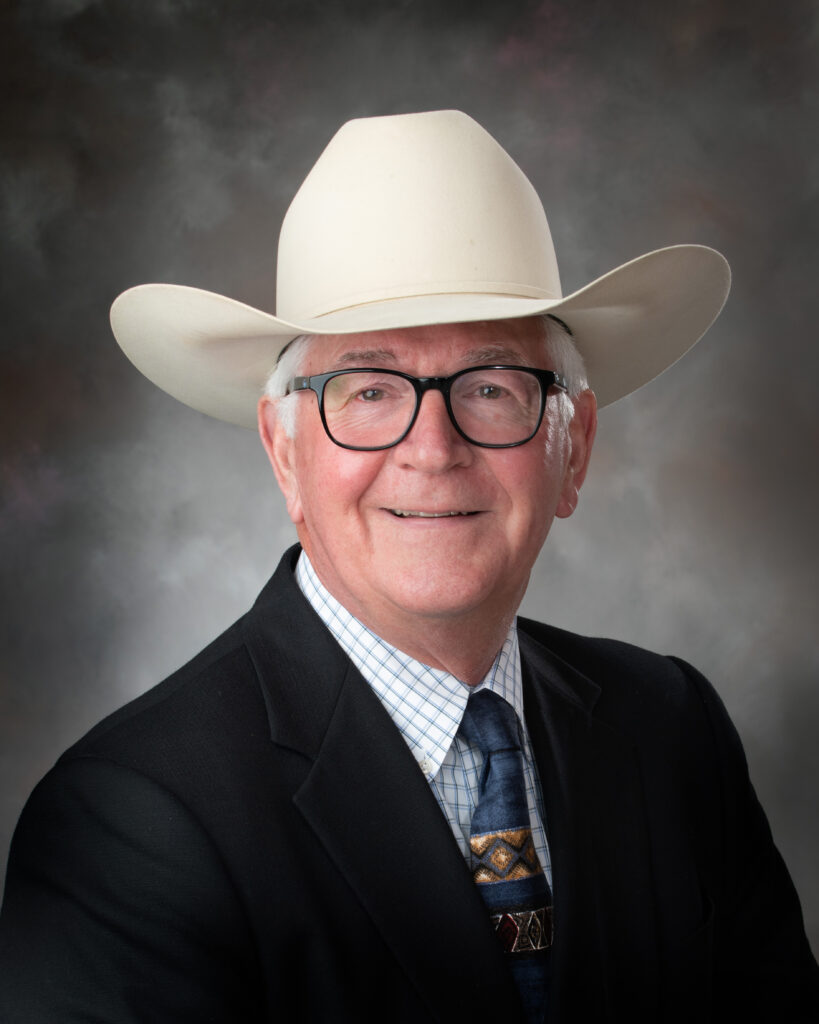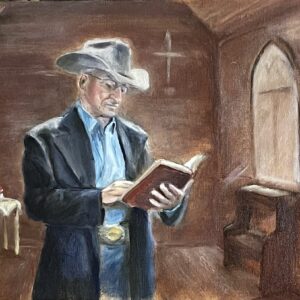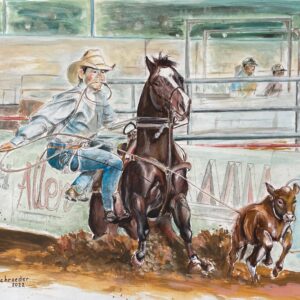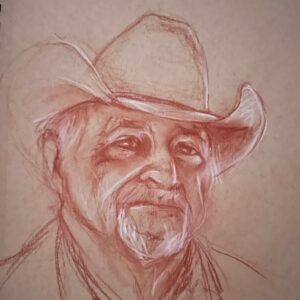Menu
Chuck Schroeder

"Saddles to Sketches:
The Far Above Average Journey of Chuck Schroeder"
Article By Bryan Painter
No one ever won an average on their first steer.
A cowboy knows that with each round, it’s essential not that they get faster but somewhat smarter. Learn from each steer and advance. Such is the life of Chuck Schroeder.
This native of southwestern Nebraska ranch country near the rural community of Palisade has linked a diverse range of leadership roles spanning academia, agriculture, cultural heritage, rural development, and artistic pursuits into a fantastic success story. Even though his story is comparable in what it takes to win an average in roping, Chuck Schroeder’s journey is significantly above average.
Preparing for life’s trail…
In the vast expanse of rural southwest Nebraska, where the horizon stretches out like an endless promise, lies the upbringing of a man whose roots run deep in the land and its people. Born into ranching and farming, his childhood was a tapestry woven with the threads of hard work, family values, and a boundless spirit of curiosity.
Gene and Madeline Schroeder, pillars of their community, raised their youngest son amidst the rolling plains and amber waves of grain. Their ranch, a mosaic of registered Hereford cattle, swine, dairy, and fields of corn, wheat, and alfalfa, was a testament to their dedication and passion for the land.
As the youngest of six children, with three older stepsisters and two stepbrothers, he found himself immersed in a bustling household filled with the echoes of laughter and the warmth of familial love. Despite the age gap, each sibling played a vital role in shaping his formative years, instilling in him the values of integrity, resilience, and compassion.
From an early age, he was drawn to the world of livestock and horsemanship, spending countless hours by his father’s side tending to the cattle and nurturing a deep appreciation for the bond between man and beast. It was here, amidst the cattle and around the thundering hooves of horses, that he learned the true meaning of trust and respect – principles that would guide him throughout his life.
But his upbringing was not confined to the ranch alone. With parents deeply involved in community affairs, he was immersed in politics, religion, and civic engagement. From school board meetings to national conventions, he was exposed to many ideas and perspectives, igniting a passion for change and knowledge within him.
At the heart of it all was the family dinner table, where spirited debates and lively discussions were as commonplace as the evening sun setting over the prairie. No topic was off-limits here, and ambitious dreams were met with encouragement and support. It was a place where ideas took flight, and the seeds of his future endeavors were sown.
Yet amidst the rugged landscape of rural life, there was also a softer, more artistic side to his upbringing. Surrounded by the melodies of his mother and siblings and the vibrant works of family friends, he found solace and inspiration in music and art. It was a passion that would accompany him throughout his journey, offering refuge and renewal amid life’s challenges.
As he reflects on the path that has led him here, he sees the echoes of his upbringing woven into the fabric of his identity – a tapestry rich with the colors of family, community, and the land. Nebraska has been an integral part of him everywhere, every day.
Gaining strength with each round…
In a life rich with experiences and adventures, Chuck Schroeder’s journey unfolds like the chapters of a captivating novel or the seven solid runs, with each building toward the next.
One: The Ranch
Chuck called the ranch home for the first 30 years of his life, except for his college years at the University of Nebraska. Amidst the challenges of production agriculture and the unpredictable forces of nature, Chuck honed his resilience and learned the value of hard work and perseverance. Engaging in “cowboy politics” with organizations like the Nebraska Stock Growers Association and the National Cattlemen’s Association exposed him to a broader perspective, setting the stage for his future endeavors.
Two: State Government
As a Republican appointee of Democratic Governor Bob Kerrey, Chuck entered the realm of state government, facing a unique set of challenges and opportunities. Amidst the complexities of politics, Chuck was surrounded by wise mentors who guided him in navigating alliances and bridging ideological divides. This experience laid the groundwork for his future endeavors and altered the trajectory of his life.
Three: Higher Education
Transitioning to higher education as a development officer and later as Executive Vice President of the University of Nebraska Foundation, Chuck embarked on a new career phase. Despite his initial lack of familiarity with the field, Chuck found himself immersed in a world of philanthropy and relationship-building. Guided by patient mentors, he discovered the transformative power of leveraging resources for the greater good, transcending the boundaries of his agricultural roots.
Four: National Cattlemen’s Beef Association
As the founding CEO of the National Cattlemen’s Beef Association, Chuck faced perhaps his greatest challenge. Tasked with merging two competing organizations and navigating complex issues such as disease outbreaks and political divisions, Chuck relied on the support of visionary leaders to overcome obstacles and make a lasting impact on the beef industry.
Five: National Cowboy & Western Heritage Museum
A surprising move to Oklahoma City thrust Chuck into the leadership role at the National Cowboy & Western Heritage Museum. Despite his lack of experience in the museum world, Chuck embraced the challenge, championing the institution’s cultural roots and navigating financial and cultural hurdles with the support of dedicated staff and volunteers.
Six: Rural Futures Institute
Returning to the University of Nebraska as the founding Executive Director of the Rural Futures Institute, Chuck embarked on a mission to empower rural communities and their leaders. Despite initial momentum, shifting priorities within the university hindered the institute’s progress, underscoring the importance of committed leadership and collaboration.
Seven: Schroeder Fine Art
Chuck found his true calling as an artist in a poignant culmination of his journey. A lifelong passion for drawing and painting blossomed into a full-fledged commitment, guided by respected mentors like Renate Collins and Sherrie McGraw. With the unwavering support of loved ones and a willingness to venture into uncharted waters, Chuck embraced a new chapter of creativity and self-discovery.
Through each stop on his journey, Chuck Schroeder’s resilience, adaptability, and unwavering commitment to his passions have defined his legacy, inspiring others to embrace the possibilities that lie beyond the horizon.
While artists and cowboys work with their hands, Chuck works with his heart. It’s evident even when asked about awards he’s won. How so? Because he points back to his family.
“Probably the most meaningful awards I have received are the UNL Block and Bridle Club Honoree in 2019 and the US Livestock Industry Leader of the Year award in 2024,” he said. “My father had also won those awards several decades ago, and it was special for my family when I received them.”
A tip of the hat to these cowboys…
In the realm of cowboys, horsemen, and stockmen, Chuck’s reverence extends to many individuals whose wisdom and expertise have left an indelible mark on his life. From Charlie Read to RB Warren, each figure has contributed to Chuck’s deep respect for the cowboy way of life. However, amidst this esteemed group, two men stand out as pivotal influencers, spanning nearly four decades of Chuck’s journey: Clark Brown of North Platte, Nebraska, and Doug Clark of Wayne, Oklahoma.
Chuck’s encounter with Clark Brown, facilitated by his father during college, proved transformative. Despite thinking he knew it all, Clark’s quiet demeanor and profound insight into roping techniques and life’s complexities challenged Chuck to reassess his approach in and out of the arena. Under Clark’s guidance, Chuck elevated his tie-down roping skills and underwent a significant adjustment of attitude, finding solace and clarity in Clark’s ranch and wisdom. The bond between Chuck and Clark, akin to that of second parents, fostered a deep connection that transcended the roping pen, inspiring Chuck to immortalize Clark through portraiture.
Similarly, Chuck’s acquaintance with Doug Clark, initiated by a mutual friend’s recommendation, blossomed into a friendship that altered the course of Chuck’s life. From entrusting his prized stud to Doug’s care to embarking on a competitive roping journey at Doug’s encouragement, Chuck found himself propelled into uncharted territory, both in the arena and beyond. Doug’s unwavering belief in Chuck’s abilities pushed him out of his comfort zone, instilling a sense of determination and a willingness to rise to the challenge. Through Doug’s mentorship, Chuck honed his roping skills and underwent a personal transformation that rippled into every facet of his life, including his role at the National Cowboy & Western Heritage Museum.
As Chuck transitioned into the life of an artist, his gratitude and admiration for Clark Brown and Doug Clark endured reflected in the numerous portraits he created in their honor. Their influence, akin to that of great psychologists disguised as horsemen, continues to resonate in Chuck’s artistry and their profound impact on his journey as a cowboy, an artist, and a man.
A catch and a canvas…
From when he was a high school kid, the thrill of roping calves captured his imagination like no other event. When executed flawlessly, the speed, the moment of impact, and the grace of the act intrigued him deeply. However, amidst competing demands, he never had the opportunity to rope “all the time.” Yet, he could never entirely give it up, either. For him, roping was about more than just the event itself; it was about the relationships forged with good people and horses. These connections provided a grounding force as he navigated various challenging and uncomfortable realms.
But beyond the arena, another passion that stirs his soul—the world of art exists. Art, for him, is a deeply personal expression of the world he sees, feels, and experiences. It embodies “who he is” in many ways. Hardly a day goes by without him sketching someone or something that catches his attention, sparking fascination and compelling him to capture it on a surface. As he delves deeper into his artistic endeavors, he realizes that art allows him to experience life at a much deeper level of intimacy and touch other human beings in ways he never imagined.
Having spent much of his life striving to influence large bodies of people, even his country and the world, his focus has shifted. He now finds himself most intrigued by the notion of reaching the heart of one person or one family with the work of his hands. It’s a rush unlike any other, a satisfaction that transcends the desire for mass recognition, finding fulfillment in the intimate connection forged between creator and beholder.
In a world filled with noise and chaos, this local rancher has discovered his sanctuary in the simplicity of roping and the profound expression of art, reminding us of the power and beauty of pursuing one’s passions.
Inside the art…
In the rich tapestry of Chuck’s artistic journey, several individuals stand out as guiding lights, each contributing their unique insight and encouragement to shape his path in art.
First and foremost is his wife, Kathi, whose unwavering support and encouragement have been a constant source of strength. Kathi’s insight and courage propelled Chuck to take a summer course at the Taos Institute of Art in 2001, a decision that would prove to be serendipitous, leading to a fateful encounter with Renate Collins Hume.
Renate Collins Hume, Chuck’s first “serious” art instructor, delivered a stern wake-up call that forever changed his relationship with art. Her words, “When you speak through your hands, I know the TRUTH about you! You are an artist!” ignited a spark within Chuck, propelling him to take his craft more seriously. Under Renate’s guidance and encouragement, Chuck embarked on a transformative journey, eventually leaving his position at the National Cattlemen’s Beef Association to lead the National Cowboy & Western Heritage Museum, immersing himself fully in the art world.
Sherrie McGraw, the renowned artist and teacher, played a pivotal role in Chuck’s artistic evolution. Sherrie provided invaluable mentorship and challenged Chuck to commit his life to his craft by inviting him to work in her studio in Arroyo Seco, N.M. Her influence extended beyond the canvas, shaping not only his art but also his mindset.
Taos artist J Chris Morel, a chance encounter at the Oklahoma City Arts Festival, blossomed into a deep friendship and mentorship. Chris’s guidance in landscape painting and his unwavering support as Chuck navigated the art world proved instrumental in his development as an artist. With Chris’s encouragement, Chuck embraced landscape painting with renewed enthusiasm, finding inspiration and beauty in the world around him.
Reflecting on the individuals who have influenced him most profoundly, Chuck acknowledges the trust and respect that define these relationships, underscoring the transformative power of mentorship and encouragement in his artistic journey.
Amarillo by morning…
Again, believing and getting stronger in life, art, and the arena have all played vital roles in Chuck’s life.
The 2011 American Quarter Horse Association Select World Championships in Amarillo, Texas, is a great example.
Chuck had been going to shows in 2009 and 2010 but needed more success.
“I was ready to quit, but Doug said, ‘You could compete with these guys if you’d work at it!’” he said.
At that point, his time in the practice pen more than doubled, and he hauled to more shows in 2011.
“I found myself qualified for the Select Championships,” Chuck said. “We went, and I was nervous, thinking perhaps I was out of my league. Doug, noting my anxiety, asked, ‘What are you so worried about?’”
Chuck quickly mentioned four or five ropers he thought were much better than he was.
Doug responded, “Yeah, you’ll have to rope your best to beat those guys. But you know what? Everybody else is worried about you. You have a great horse. Just trust her and rope your roping.”
Plus, he was roping with Steve Orth, a phenomenal athlete who can “see the seams on a fastball.”
“I often thought Steve knew more about how I roped than I did,” Chuck said. “Anyway, I was on autopilot when we rode down the ramp into that coliseum in Amarillo for the prelims. I was pretty jacked up but just tried to follow Doug’s orders, stick to the basics.”
The result was a solid run, which qualified them for the finals.
When they rode into the box for the finals, Steve turned to Chuck and said, “Forget all that training, get aggressive and take your first shot. Let’s try to win something.”
And they did.
“I made the corner, roped two feet, and ended up winning the Intermediate Championship in the Heeling,” Chuck said. “When I rode out of the arena, Doug hit me on the leg and said, ‘That’s execution, buddy.’ Meant a lot.”




